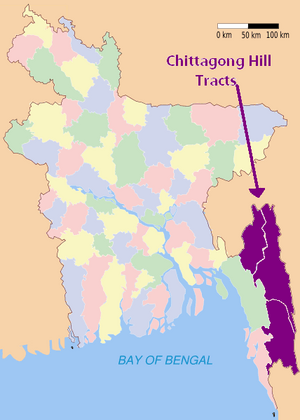Chittagong Hill Tracts facts for kids
The Chittagong Hill Tracts (CHT) is a special area in southeastern Bangladesh. It covers about 13,189 square kilometers. This region shares borders with India and Myanmar. Before 1971, it was one large district in East Pakistan. Then, it was divided into three smaller districts: Khagrachari, Rangamati, and Bandarban.
The CHT is the only truly hilly area in Bangladesh. It is home to around 800,000 indigenous people. These native groups are also known as the Jumma people. The CHT is very diverse in its geography, people, cultures, and traditions. The Jumma people are different from the majority Bengali people in Bangladesh. They have their own unique race, languages, cultures, traditions, religions, and history.
When India was divided in 1948, the CHT became part of East Pakistan (now Bangladesh). This happened even though most people in the CHT were Buddhist, not Muslim. Today, most people are Buddhist, with some Christians and followers of traditional beliefs. There are 13 main ethnic groups, including the Chakma, Tipra, Murong, Marma, and others. They speak ten different indigenous languages. A small number of people from other groups like Ahamiya and Santal also live there. All these native groups call themselves the Jumma people, meaning "High Landers."
However, about half of the people living in the CHT today are Bengali Muslim settlers who moved there. After Bangladesh became independent, more and more settlers came from other parts of the country. This was encouraged by the government. The native people started to resist these changes. At first, they used political and civil ways. Later, in the 1980s, some groups, like the Shanti Bahini, started an armed resistance. Because of this, the area became very militarized. The police and army caused many problems for the local people.
In 1987, a group called the Jana Samhati Samiti made five main demands for the CHT:
- 1. The CHT should have its own government and law-making assembly. They wanted the right to decide their own future.
- 2. This right should be written into the country's main laws (the Constitution).
- 3. All non-native people who settled in the CHT after 1947 should leave.
- 4. The government should provide money to help the region develop.
- 5. A good environment should be created to find a peaceful solution to the problems.
On December 2, 1997, a "Peace Agreement" was signed. The government and the Parbatya Chattagram Jana Sanghati Samiti, which represented the indigenous people, signed it. This agreement gave a limited amount of self-rule to the three districts of the CHT. The Jana Samhati Samiti became a political party. However, this agreement has not been fully put into action. Some political groups in Bangladesh and even some parts of the Shanti Bahini did not agree with it.
Contents
History of the Chittagong Hill Tracts
Before outsiders came, the indigenous Jumma people of the CHT lived independently. No outside power interfered with their lives until 1787. That year, an agreement was signed with the British. The British officially started to control the CHT in 1860. From 1787 to 1860, the British government did not get involved in the CHT's internal affairs.
After 1860 and until 1900, the British government managed the CHT using special rules. In 1881, the CHT Police Force was created with Jumma people to maintain order. In 1900, the British government passed the CHT Regulation 1 of 1900. This law declared the CHT an "Excluded Area." This meant it was protected from economic exploitation by non-native Bengali people. It also helped preserve the Jumma people's traditional ways of life, their community land ownership, and their political systems.
CHT Under Pakistan's Rule
When India was divided, the CHT became part of Dominion of Pakistan. The Pakistani government continued to recognize the CHT as an Excluded Area. Even in Pakistan's first Constitution in 1956, the CHT was still an Excluded Area under the 1900 Regulation.
However, from the beginning, the Pakistani government viewed the Jumma people with suspicion. They thought the Jumma people were against Pakistan and against Islam. There was unfair treatment of the Jumma people in jobs, businesses, and education. In 1948, the government showed its policy by getting rid of the CHT Frontier Police Regulation. This meant the Jumma police force was disbanded.
In 1950, the Pakistani government started a program to settle Bengali Muslims in the CHT. This went against the spirit of the 1900 Regulation. This program continued until 1966. The government also passed a law in 1958 to take over the Jumma people's ancestral lands. In 1963, they took away the Jumma people's rights and special status by ending the "Excluded Area" status of the CHT.
In 1960, the Pakistani government built the Kaptai hydro-electric dam on the Karnaphuli river. This dam was in the heart of the Jumma people's land. It was built for industrial development, but it also caused many problems for the Jumma people and their economy.
Conflict and Peace Efforts
During the war for Bangladesh's independence in 1971, the Chakma King had different views. Because of this, when Bangladesh became independent, the native people's request for special status was not heard. The Chakma King later left for Pakistan.
Meanwhile, more and more Bengalis moved into the area, settling on the land. In 1973, the native people started an armed resistance. To counter this, the government began giving permits to landless Bengalis to settle there in 1979. This allowed them to claim tribal land. This practice continued for six years. It led to about 400,000 people moving into the area. This was almost as many as all the tribal groups combined. Many difficult situations occurred as the army tried to stop the revolt.
From 1973 until 1997, the Hill Tracts area saw fighting between the Bangladeshi army and the Shanti Bahini rebels. The problems came from the cultural differences between the native groups and the people from the plains. After nine months of war against Pakistan, Bangladesh became an independent country on December 16, 1971. The Jumma people hoped that the new leaders of Bangladesh would understand their needs. So, they asked the government for regional self-rule in a peaceful way.
However, the government of Bangladesh did not respect their basic rights. The Constitution did not even mention the Jumma people or how to protect them. Instead, the CHT became militarized soon after Bangladesh's independence in early 1972. When the Jumma people's peaceful movement was met with harsh actions by the government, including building three army camps, Manabendra Narayan Larma, a leader of the Jumma movement, called for an armed struggle. An armed group called Shanti Bahini (Peace Force) was formed.
Since 1979, the Government of Bangladesh started a big program to settle Bengali people from other districts into the CHT. The goal was for them to outnumber the Jumma people. At least 400,000 Bengali Muslims were moved into the CHT and settled on the Jumma people’s lands.
The PCJSS (the political group of the Jumma people) always wanted to solve the CHT problem peacefully. They held many talks with different governments. Finally, after several rounds of talks with the Sheikh Hasina government, the 'CHT Accord' was signed. This happened between the government and the PCJSS in Dhaka on December 2, 1997.
Images for kids
-
The Hanging Bridge, Rangamati Hill District
See also
 In Spanish: Chittagong Hill Tracts para niños
In Spanish: Chittagong Hill Tracts para niños






